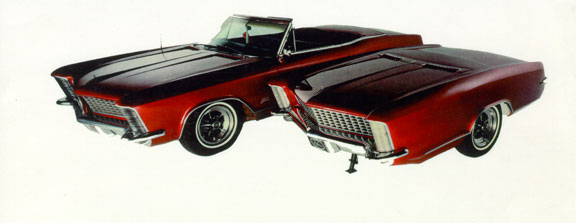Sun Car
The "SUN CAR" received its name after the roof had been removed
from the 1965 2-door hardtop. The car had no top, but since it never rains
in southern California, the good times outweighed the “wet”
times. For you purists, the state of the steel roof was non-repairable.
Moisture trapped by the original vinyl top had rusted the roof completely
through in so many areas you could poke your finger through it with little
effort. The name “SUN CAR” came from its original California
black license plate, SCA 095.
The Trailer Story
In 1985, I had just attended the Buick Car Club of America’s (BCA) National Meet which was held at the Universal Studios in Los Angeles. Met Ray Knot who had just started the Riviera Owners Association. This was the first showing of my “Sun Car”, a 1965 Buick Riviera converted to an open car. As I was basking in the afterglow, reality set in and I realized my dream car had a ‘storage problem’. My family usually accompanied me to the meets, and with the extra equipment necessary to get the car ready for display, there just simply wasn’t enough room.
On the way home, heading south on Interstate 5, I was following Mary Ellen and Leonard Scott in her 1964 Riviera when a unique thought occurred to me. What if … you could take the quarter panels and trunk section of a 1965 Riviera and make a trailer out of it, like what is done with the bed of a pick-up truck. Over several months the idea was sketched many times, but nothing seemed to work as a way to finish the front end. It would be nice if the grille could somehow be added to give the project a finished look. Then, one day I checked the lines of the fenders with the quarter panels and discovered they were closely matched. It might just work. The challenge to me would be to combine the elegant styling of the 1965 Riviera front end and its trunk by simply removing the passenger compartment. Two years later, I had a 10’ trailer with operational hood and trunk compartments. The hood opened with the original locking mechanism and the trunk was operated by a 1963 vacuum trunk release located under the hood.
I bought a 1965 Riviera that was abandoned in Boulevard, California and had it trailered to San Diego. It was a basket case, sitting on its frame, with no wheels or brake drums. But the dry desert air had preserved the exceptionally sound body with a light overall surface rust, which was just perfect for what I had in mind.
The car was disassembled, leaving only the quarter panels and deck lid on the chassis. The fenders were test fit to determine the space required to fit the hood and cowl in front of the trunk. This accomplished two things: it allowed the hood and fender to meet normally, and it permitted the correct alignment of the side bodyline of the quarter panel. Witness lines were placed on the fender and quarter panels to permit their realignment after they were cut. The fenders were removed and the quarter panels were trimmed. The fenders were reinstalled with clamps and the upper radiator support bar and the splash pan below the grille were installed to space the two front fenders. Temporary bracing from the floor to the upper corners of the front fenders were installed. The front fenders were tack welded to the quarter panels. This left a large hole from the front wheel well opening. The rear section of the front fender, where the “RIVIERA” script is located, was used to fill this gap. A small piece of sheet metal was hand-formed to turn the reverse curve at the bottom of the quarter panel back into the fender.
The hood hinges were attached to the fenders using their normal holes, and the rear point that attaches to the firewall were now mounted to the front of the rear wheel wells. The cowl mounting tray was constructed to support the cowl. At this point things looked pretty good – the front fenders were hammer welded and finished off.
Work moved to the trunk area. The problem here is the trunk turns up to meet the roofline. Looking at the side of the 1965 Riviera you can see that the front of the trunk lid is 1 ½” higher than the quarter panel. This would make the filler panel between the trunk lid and the cowl too high. This problem was overcome by trunk hinge brackets attached to the rear wheel wells, which were cut to permit the deck lid assembly to be pushed down inside the trunk. The trunk hinges were shimmed and the trunk lid adjusted to the most favorable positions.
From day one, the major problem that delayed me was how to form the filler panel between the trunk and the cowl. A wood buck was made to match the shape of the leading edge of the trunk lid. A flat sheet of 18 gauge sheet metal, 18”X6’, was hammered over the buck to form a ½” lip. This lip gave the flat panel some of the gentle crown shape that was required to match the trunk. (This lip would later be added to additional pieces inside of the trunk to anchor the panel.) More crown was required to shape the overall panel. This is normally done on an “English Roller”. But, not having this piece of equipment, the panel was shaped with a body hammer on a sand bag.
So you want to make your own Riviera Trailer.
Click here for the "How To".



